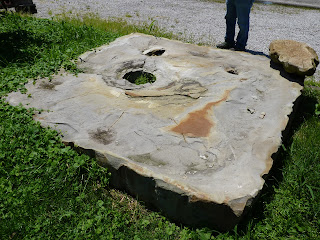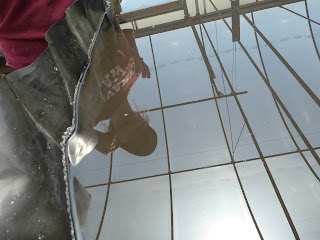One of the earliest industries in West Virginia was nearly forgotten about until recently, when the J. Q. Dickinson Salt Works revived the salt-making business that had been in their family since the very early 1800's. I've read several accounts of West Virginia salt history, and there are some conflicting facts and dates, so if you see a glaring error in this post, please comment below.
Salt was a precious commodity in pioneer times, as it was needed to preserve meat. Most settlers found a salt lick (a spring where the water is salty) and boiled down their own supply, a process that could take days of labor and hundreds of gallons of water. Finding a lick was easy--simply follow the wildlife. Even today many roads in West Virginia and probably other Appalachian states are named things like Buffalo Lick, Stone Lick, Big Lick, etc.
I had heard about the re-opening of the Kanawha Valley salt works a few years ago, and we finally had an opportunity to visit. I had always heard this referred to as "salt mines" but in reality the salty water is brought to the surface with brine wells. Tobias Ruffner and his brother David drilled the first deep brine well in 1808 and found an underground reservoir (the ancient Iapetus Ocean) that produced more brine that anyone would have thought possible. Tobias was a true gadgeteer and homespun engineer, building most of his own tools as the need arose; he was the butt of many jokes until his determination paid off. His well is believed to be the first deep bored well in the United States. The Ruffners also were the first to use coal to fire their evaporators, instead of the traditional wood. Most of the forests in the area had been cut to feed the hungry salt industry, so coal was a good alternative and was abundant in the region.
 Thousands of people worked at the salt works and wells were drilled up and down the valley as more people got into the salt business. One of those was the Dickinson family, who operated wells first with rented equipment in the area of present-day Belle, but in 1814 moved to Malden to the area called the Kanawha Salines and drilled their first brine well in that area in 1817. There they became part of the trust known as the Kanawha Salt Company, which was a group of four salt producers who sought to regulate the quality and the price for salt, as prices began to plummet with so many wells in production. The legendary former slave Booker T. Washington worked in the salt works as a young child after slavery was abolished, and described the work as grueling and his life in early Malden as hard and primitive, scrabbling for survival. I am sure his experience was echoed by many of the people who worked in the industry.
Thousands of people worked at the salt works and wells were drilled up and down the valley as more people got into the salt business. One of those was the Dickinson family, who operated wells first with rented equipment in the area of present-day Belle, but in 1814 moved to Malden to the area called the Kanawha Salines and drilled their first brine well in that area in 1817. There they became part of the trust known as the Kanawha Salt Company, which was a group of four salt producers who sought to regulate the quality and the price for salt, as prices began to plummet with so many wells in production. The legendary former slave Booker T. Washington worked in the salt works as a young child after slavery was abolished, and described the work as grueling and his life in early Malden as hard and primitive, scrabbling for survival. I am sure his experience was echoed by many of the people who worked in the industry.
The saltworks continued in operation until the mid-70's, although the salt produced was not, I think, for home use. Rather it was in demand in the growing chemical industry in the Kanawha Valley. My husband remembers visiting a friend who had served in Vietnam with him who worked at the Malden works and lived in one of the cabins reserved for workers on the property. These cabins still stand, I understand, but they and some other sites of the original workings are now private property and off limits to visitors. The works eventually shut down until the descendants of the original Dickinson family decided to revive the business and create gourmet table and cooking salts. Now there are tours of the new works, a gift shop and monthly farm-to-table dinners, along with other activities offered to celebrate the revival of an old tradition.
I was fascinated by the whole process, and the history behind it. The early way of extracting brine was a dangerous, tricky enterprise. Large hollow trees were lowered into holes dug into the muddy licks, and men were lowered into these to send up buckets of the brine, according to our tour guide.
Men could only stay down in the wells a certain length of time before they had to be brought back to the surface; derricks similar to those of oil wells were used for these wells as well as the later ones.
This is one of the early well sites, I think the guide said. The large stone to the right was on top of the large gray stone structure. The one of the right is one solid piece. The company is not sure how exactly this well operated. I was just stunned at the size of that stone slab!
Today the brine is pumped from the wells with modern electric pumps, and stored in large tanks for a day or two to allow some of the sediment to settle. Then it is sent to the salt houses and the process begins. Solar power is used for evaporation instead of wood or coal, so it's a far more ecologically friendly process.
Here is the brine in one of the sunhouses, which resemble large greenhouses. In these houses the brine is allowed to evaporate and the calcium separates and sinks to the bottom of the trays.
It was pretty warm and steamy in here--my camera lens fogged immediately and I had to clean it often to take photos.
From the sunhouses the brine is transferred to another large tank, and finally to the last step of the process.
Here, you can see the salt crystals forming. They are remarkably beautiful, very white and square! I thought they had settled to the bottom, but actually the crystals are floating on top. When they have been in these trays a day or so (I can't remember exactly what our guide said), they are raked up with the skimmer (the long-handled tool in the below photo), and then scooped up into buckets with the wood scoop.The process is repeated 2 or 3 times for each tray, and the crystals get smaller each time.
You can see salt gathering bere on the sides of this new tray which had just been filled that morning.
The final step: The salt is sifted, cleaned by minute inspection, and put into flour-sack fabric bags.
Cleaning is done literally with a pair of tweezers! Each batch is carefully inspected and any minute fleck of dark matter is removed.
Finished, graded and ready to package.
In the gift shop, a model of the original works is displayed. This was made by a prison inmate who was taking a class that required a project based on history. He chose the salt works and did an excellent job.
Several different products are offered for sale in the gift shop. There is the table salt, available in grinders or bags, pioneer salt which is reddish-brown and is like the salt the early settler made. It is often purchased by historical groups and re-enactors, and has a strong iron flavor. There are also flavored salts offered in gift packs, and an incredible burnt caramel sauce that tastes better than any I have ever tasted.
We came home with a grinder and some caramel sauce. I wondered if there would really be a difference in the taste of the salt. I mean, salt is salt, right? I was startled by the clarity of the flavor--I can best describe it as clear and bright. We don't seem to use as much of it either. The grinder is refillable and refill salt can be ordered online.
We tasted the caramel sauce at the gift shop and I can't wait to get some good vanilla ice cream to go with it. Delicious!
And if you're interested in more history about salt-making in West Virginia, these are the resources I consulted for this post:
Dickinson Family. West Virginia Encyclopedia Online.
Fallows, James. Artisanal Salt from an Ancient Sea. Atlantic magazine, Dec 5, 2014.
History of the Great Kanawha Valley [West Virginia], Volume 1. Brant, Fuller & Co., pp 166. (Online at Amazon.com)
History of West Virginia Mineral Industries--Salt. WV Geological and Economic Survey.
Ruffner Family. West Virginia Encyclopedia Online and West Virginia Heritage Encyclopedia,
Volume 19, published by Jim Comstock, Richwood, WV 1976, pp 4175-4176.
Tobias Ruffner.West Virginia Heritage Encyclopedia, vol 19, pp 4176-4179.
Salt industry history. West Virginia Heritage Encyclopedia,vol 19, pp 4210-4211.
Booker T. Washington and saltmaking. West Virginia Heritage Encyclopedia, vol. 19, pp 4181-4182.
Settle, Mary Lee. Addie: A Memoir. University of South Carolina Press, 1998.
Copyright Susanna Holstein. All rights reserved. No Republication or Redistribution Allowed without attribution to Susanna Holstein.



















This is a wonderful post about our Appalachian heritage. Glad to see this process back in action.
ReplyDeleteThank you, Michelle. I've been interested in the salt history since I first heard about the workings in Malden. So odd to think of salt water bubbling to the surface!
ReplyDeleteThat was a really interesting post. I love visiting places like this. Thanks for sharing.
ReplyDeleteVery interesting story, and now I want to order some of the salt!
ReplyDeleteI saw a docu on how it´s done in France - different process!
ReplyDeleteVery interesting post.
Haha, we have salt from the Murray River in Australia - it has an "expiration date"! Salt!!!!